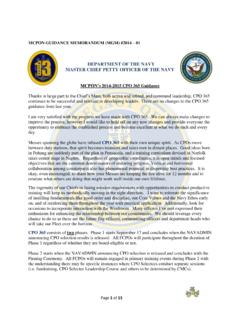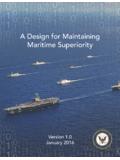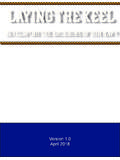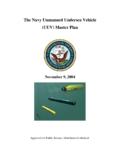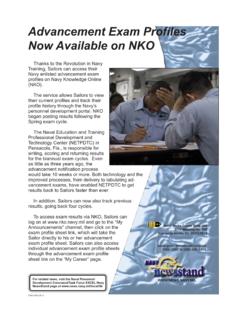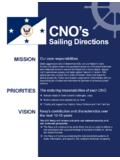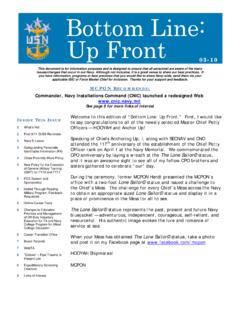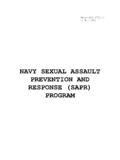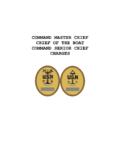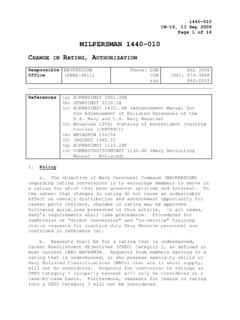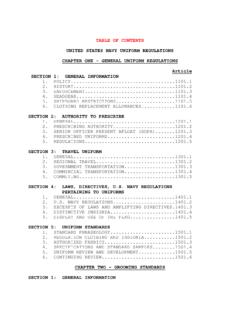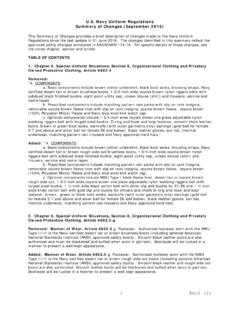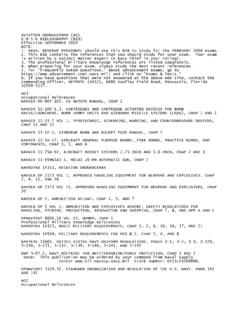Transcription of U.S. Navy Social Media Handbook
1 The navy Social Media Handbook The navy Social Media Handbook navy Office of navy Social Media Handbook navy Social Media Handbookfor navy leaders, communicators, Sailors, families, ombudsmen and civiliansJanuary 2018iv The navy Social Media handbookINtroductIoNINTRODUCTIONS ocial Media continues to revolutionize our lives, from the way we communicate and interact with the world to the content we see and the news we read. As a result, the way people get information has drastically changed, and the desire to have real-time conversations with individuals, organizations and government entities has increased. this presents a tremendous opportunity for everyone, from Sailors and families to navy leaders and ombudsmen, to more effectively communicate with one another and to share the navy story more broadly. the proper and effective use of Social Media presents unequaled opportunities for you to share our navy s story in an authentic, transparent and rapid manner while building richer, more substantive relationships with people you may not have reached through traditional communication channels.
2 At the same time, the open, global nature of Social Media creates new challenges, operational and cybersecurity considerations as well as concerns regarding online conduct. New decisions on which platforms are best to use ensure the most relevant information is conveyed are being deliberate in real-time as platforms rapidly adapt, age-out or emerge. this Handbook s sections are tailored to the unique audience it s serving: navy leaders, communicators, Sailors, families, ombudsmen and Social Media is constantly evolving, we ve included only enduring information that will remain relevant. We encourage you to frequently visit for the latest policy, guidelines, best practices, standard operating procedures, training and other you have questions or want to share feedback, contact the navy office of Information at 703-614-9154 or The navy Social Media Handbook The navy Social Media handbooktAble of coNteNtSContentsLEADERS 2overview of today s online landscape.
3 2unofficial (Personal) use of Social Media ..3 Setting the Standard for online conduct ..3reporting Incidents ..4operations Security (oPSec) ..4 Politics ..5endorsements ..5 Impersonators ..5 navy COMMUNICATORS 6overview of today s online landscape ..7official use of Social Media for navy commands..7 Policy..8deciding if Social Media is right for a command ..9 Alternatives ..9 Strategy development ..9content Planning ..10crisis communication: casualties and Adverse Incidents ..12 Account Security ..17operations Security (oPSec) ..18 Politics and endorsements ..18online Advertising..19online conduct ..19 Impersonators ..19 SAILORS 20online conduct ..20follow the ucMJ ..20reporting Incidents ..21 Politics ..21cybersecurity ..21operations Security (oPSec) ..21 Adverse Incidents ..22endorsements ..22 The navy Social Media Handbook 23cybersecurity .. 23operations Security (oPSec).
4 23 Adverse Incidents .. 24 OMBUDSMEN 25overview of today s landscape .. 25best Practices to Support command s official Social Media Presence(s) .. 25cybersecurity .. 26operations Security (oPSec) .. 26 Adverse Incidents .. 27 Private Groups .. 27 DEPARTMENT OF THE navy CIVILIANS 28cybersecurity .. 28operations Security (oPSec) .. 28online conduct .. 28 Politics .. 29 APPENDIX 30online conduct .. 30 Joining Networks .. 30 Setting Guidelines .. 30the ucMJ and navy regulations .. 30behaviors with legal consequences .. 31reporting Incidents .. 31bottom line .. 31online Safety and best Practices .. 32 Security .. 332 The navy Social Media handbookleAderSLEADERSthe navy has an obligation to provide timely and accurate information to the public, keep our Sailors and department of the navy civilians as well as their families informed, and build relationships with our communities.
5 As a navy leader, you are a crucial part of those communication efforts. Social Media presents unequaled opportunities for you to share the navy story in an authentic, transparent and rapid manner while building richer, more substantive relationships with people you may not have reached through traditional communication channels. It is important to remember that the effective use of Social Media is only part of a command s public affairs program. navy leaders need to work with their public affairs team to decide whether Social Media is appropriate for their command; not every command needs to use Social Media . conversations about the navy will still take place on Social Media ; however, they will not include the navy s perspective. Overview of Today s Online LandscapeSocial Media usage is nearly universal among younger adults and is quickly growing among people over age 50. People use it to consume news, make or strengthen connections, and engage in discussions and activism related to personal interests.
6 There are many different Social Media platforms, each with distinct use cases. navy leaders need to work with their public affairs team to focus their efforts on a Social Media platform that aligns with the command s communications objectives and that its targeted audiences use to a study conducted in 2016 by Pew research center, the percentage of adults who use at least one Social Media site is as follows: 82 percent of 18-29 year olds, 77 percent of 30-49 year olds, 65 percent of 50-64 year olds, and 35 percent of people age 65 and above. In total, nearly 70 percent of adults use Social Media . Specifically, 68 percent use facebook, 25 percent use Instagram and 21 percent use twitter. of the 68 percent of adults using facebook, over 75 percent go onto the platform every day. fewer users reported logging onto Instagram (51 percent) and twitter (42 percent) majority of facebook users (66 percent) say they mostly friend or follow people they know personally on facebook.
7 They don t necessarily log onto it for news; 62 percent of users say they see it on facebook while doing other things. conversely, 54 percent of twitter users say they re looking for news on twitter. only 15 percent of twitter users reported that they normally follow people they know personally, whereas 48 percent say they mostly follow people they don t know personally. This Handbook will teach you the best practices that you should follow while communicating about the navy on Social navy Social Media Handbook (Personal) Use of Social Mediaunofficial internet posts are posts published on any internet site by a Sailor or a department of the navy civilian in an unofficial, personal capacity that include content about and/or related to the navy or term posts includes, but is not limited to, personal comments, blogs, photographs, videos and graphics. the term internet sites includes, but is not limited to, Social networking platforms, messaging apps, photo- and video-sharing apps and sites, blogs, forums and websites with comment you are expressing a personal opinion of any kind, it is your responsibility to make clear that you are not speaking for the navy and that the stance is your own and not representative of the views of the navy .
8 !Behaviors with legal consequences include: child exploitation/child sexual exploitation computer misuse ( hacking ) cyber stalking electronic harassment electronic threats obscenityconsult your command s JAG for legal the Standard for Online ConductAs a navy leader, you must lead by example and show your Sailors and navy civilians that improper online behavior is not tolerated and must be reported if experienced or witnessed. When it comes to your position as command leadership, your conduct online should be no different than your conduct offline and you should hold your Sailors and civilians to that same evidence of a violation of command policy, uniform code of Military Justice or civil law by one of your Sailors or navy civilians comes to your attention from Social Media , then you can act on it just as if it were witnessed in any other public location. Additionally, pursuant to navy regulations, you have an affirmative obligation to act upon offenses under the ucMJ which come under your observation.
9 This adds an ethical wrinkle to friending or following your subordinates; the key is for you to maintain the same relationship with them at work as you do online and to be clear about using Social Media are subject to the ucMJ and navy regulations at all times, even when off duty. commenting, posting or linking to material that violates the ucMJ or navy regulations may result in administrative or disciplinary action, to include administrative separation, and may subject navy civilians to appropriate disciplinary action may include Articles 88, 89, 91, 92, 120b, 120c, 133 or 134 (General Article provisions,contempt, disrespect, Insubordination, Indecent language, communicating a threat, Solicitation tocommit another offense, and child Pornography offenses), as well as other articles, including navy regulations Article 1168, nonconsensual distribution or broadcast of an intimate image.
10 4 The navy Social Media handbookleAderSReporting IncidentsAny member of the navy community who experiences or witnesses incidents of improper online behavior should promptly report it to their chain of command via the command Managed equal opportunity manager or fleet and family Support office. Additional avenues for reporting include equal employment opportunity offices, the Inspector General, Sexual Assault Prevention and response offices and Naval criminal Investigative Service. NcIS encourages anyone with knowledge of criminal activity to report it to their local NcIS field office directly or via web or smartphone instructions are available at to the Handbook s appendix for additional Security (OPSEC)one of the best features of Social Media platforms is the ability to connect people from across the world in spontaneous and interactive ways. like most things that we do as a navy , Social Media can present risks and challenges such as oPSec, but they can be mitigated.
